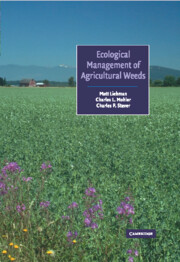Book contents
- Frontmatter
- Contents
- Preface
- 1 Weed management: a need for ecological approaches
- 2 Weed life history: identifying vulnerabilities
- 3 Knowledge, science, and practice in ecological weed management: farmer–extensionist–scientist interactions
- 4 Mechanical management of weeds
- 5 Weeds and the soil environment
- 6 Enhancing the competitive ability of crops
- 7 Crop diversification for weed management
- 8 Managing weeds with insects and pathogens
- 9 Livestock grazing for weed management
- 10 Weed evolution and community structure
- 11 Weed management: the broader context
- Taxonomic index
- Subject index
2 - Weed life history: identifying vulnerabilities
Published online by Cambridge University Press: 10 November 2009
- Frontmatter
- Contents
- Preface
- 1 Weed management: a need for ecological approaches
- 2 Weed life history: identifying vulnerabilities
- 3 Knowledge, science, and practice in ecological weed management: farmer–extensionist–scientist interactions
- 4 Mechanical management of weeds
- 5 Weeds and the soil environment
- 6 Enhancing the competitive ability of crops
- 7 Crop diversification for weed management
- 8 Managing weeds with insects and pathogens
- 9 Livestock grazing for weed management
- 10 Weed evolution and community structure
- 11 Weed management: the broader context
- Taxonomic index
- Subject index
Summary
Weeds from an ecological perspective
Weeds share certain ecological characteristics that distinguish them from other plants. Specifically, weeds are plants that are especially successful at colonizing disturbed, but potentially productive, sites and at maintaining their abundance under conditions of repeated disturbance. That is, weeds are the plants that thrive where soil and climate are favorable to plant growth, but disturbance frequently reduces competition among plants to low levels. Unlike previous conceptions of weediness (Baker, 1965; Harlan & de Wet, 1965; Buchholtz et al., 1967), this ecologically based definition lacks reference to humans and human disturbance. The species people refer to as weeds mostly existed prior to human disturbance, and the repertoire of behaviors that makes them invasive and persistent in human-dominated habitats largely evolved independently of human society. Nevertheless, as discussed in Chapter 10, human activities selectively modify weed characteristics such that weeds are becoming better adapted to human disturbance regimes.
The subcategory of weeds dealt with in this book consists of the weeds of agriculture – specifically, the plants that colonize and increase in the disturbances created by farming. These are sometimes termed agrestal weeds, as distinguished from the ruderal weeds of roadsides, waste piles, and other non-agricultural disturbances (Baker, 1965). Agricultural weeds share certain life-history characteristics that adapt them for life on farms (Table 2.1). The thesis of this chapter is that understanding life-history characteristics provides insights into how weed management practices work and how they can be improved.
- Type
- Chapter
- Information
- Ecological Management of Agricultural Weeds , pp. 40 - 98Publisher: Cambridge University PressPrint publication year: 2001
- 39
- Cited by



